Sangwoo Park
Shitz
Rethinking Reward Models for Multi-Domain Test-Time Scaling
Oct 02, 2025Abstract:The reliability of large language models (LLMs) during test-time scaling is often assessed with \emph{external verifiers} or \emph{reward models} that distinguish correct reasoning from flawed logic. Prior work generally assumes that process reward models (PRMs), which score every intermediate reasoning step, outperform outcome reward models (ORMs) that assess only the final answer. This view is based mainly on evidence from narrow, math-adjacent domains. We present the first unified evaluation of four reward model variants, discriminative ORM and PRM (\DisORM, \DisPRM) and generative ORM and PRM (\GenORM, \GenPRM), across 14 diverse domains. Contrary to conventional wisdom, we find that (i) \DisORM performs on par with \DisPRM, (ii) \GenPRM is not competitive, and (iii) overall, \GenORM is the most robust, yielding significant and consistent gains across every tested domain. We attribute this to PRM-style stepwise scoring, which inherits label noise from LLM auto-labeling and has difficulty evaluating long reasoning trajectories, including those involving self-correcting reasoning. Our theoretical analysis shows that step-wise aggregation compounds errors as reasoning length grows, and our empirical observations confirm this effect. These findings challenge the prevailing assumption that fine-grained supervision is always better and support generative outcome verification for multi-domain deployment. We publicly release our code, datasets, and checkpoints at \href{https://github.com/db-Lee/Multi-RM}{\underline{\small\texttt{https://github.com/db-Lee/Multi-RM}}} to facilitate future research in multi-domain settings.
Data-Efficient Prediction-Powered Calibration via Cross-Validation
Jul 27, 2025Abstract:Calibration data are necessary to formally quantify the uncertainty of the decisions produced by an existing artificial intelligence (AI) model. To overcome the common issue of scarce calibration data, a promising approach is to employ synthetic labels produced by a (generally different) predictive model. However, fine-tuning the label-generating predictor on the inference task of interest, as well as estimating the residual bias of the synthetic labels, demand additional data, potentially exacerbating the calibration data scarcity problem. This paper introduces a novel approach that efficiently utilizes limited calibration data to simultaneously fine-tune a predictor and estimate the bias of the synthetic labels. The proposed method yields prediction sets with rigorous coverage guarantees for AI-generated decisions. Experimental results on an indoor localization problem validate the effectiveness and performance gains of our solution.
Adaptive Prediction-Powered AutoEval with Reliability and Efficiency Guarantees
May 24, 2025Abstract:Selecting artificial intelligence (AI) models, such as large language models (LLMs), from multiple candidates requires accurate performance estimation. This is ideally achieved through empirical evaluations involving abundant real-world data. However, such evaluations are costly and impractical at scale. To address this challenge, autoevaluation methods leverage synthetic data produced by automated evaluators, such as LLMs-as-judges, reducing variance but potentially introducing bias. Recent approaches have employed semi-supervised prediction-powered inference (\texttt{PPI}) to correct for the bias of autoevaluators. However, the use of autoevaluators may lead in practice to a degradation in sample efficiency compared to conventional methods using only real-world data. In this paper, we propose \texttt{R-AutoEval+}, a novel framework that provides finite-sample reliability guarantees on the model evaluation, while also ensuring an enhanced (or at least no worse) sample efficiency compared to conventional methods. The key innovation of \texttt{R-AutoEval+} is an adaptive construction of the model evaluation variable, which dynamically tunes its reliance on synthetic data, reverting to conventional methods when the autoevaluator is insufficiently accurate. Experiments on the use of LLMs-as-judges for the optimization of quantization settings for the weights of an LLM, and for prompt design in LLMs confirm the reliability and efficiency of \texttt{R-AutoEval+}.
FedSVD: Adaptive Orthogonalization for Private Federated Learning with LoRA
May 19, 2025Abstract:Low-Rank Adaptation (LoRA), which introduces a product of two trainable low-rank matrices into frozen pre-trained weights, is widely used for efficient fine-tuning of language models in federated learning (FL). However, when combined with differentially private stochastic gradient descent (DP-SGD), LoRA faces substantial noise amplification: DP-SGD perturbs per-sample gradients, and the matrix multiplication of the LoRA update ($BA$) intensifies this effect. Freezing one matrix (e.g., $A$) reduces the noise but restricts model expressiveness, often resulting in suboptimal adaptation. To address this, we propose FedSVD, a simple yet effective method that introduces a global reparameterization based on singular value decomposition (SVD). In our approach, each client optimizes only the $B$ matrix and transmits it to the server. The server aggregates the $B$ matrices, computes the product $BA$ using the previous $A$, and refactorizes the result via SVD. This yields a new adaptive $A$ composed of the orthonormal right singular vectors of $BA$, and an updated $B$ containing the remaining SVD components. This reparameterization avoids quadratic noise amplification, while allowing $A$ to better capture the principal directions of the aggregate updates. Moreover, the orthonormal structure of $A$ bounds the gradient norms of $B$ and preserves more signal under DP-SGD, as confirmed by our theoretical analysis. As a result, FedSVD consistently improves stability and performance across a variety of privacy settings and benchmarks, outperforming relevant baselines under both private and non-private regimes.
Conformal Calibration: Ensuring the Reliability of Black-Box AI in Wireless Systems
Apr 16, 2025Abstract:AI is poised to revolutionize telecommunication networks by boosting efficiency, automation, and decision-making. However, the black-box nature of most AI models introduces substantial risk, possibly deterring adoption by network operators. These risks are not addressed by the current prevailing deployment strategy, which typically follows a best-effort train-and-deploy paradigm. This paper reviews conformal calibration, a general framework that moves beyond the state of the art by adopting computationally lightweight, advanced statistical tools that offer formal reliability guarantees without requiring further training or fine-tuning. Conformal calibration encompasses pre-deployment calibration via uncertainty quantification or hyperparameter selection; online monitoring to detect and mitigate failures in real time; and counterfactual post-deployment performance analysis to address "what if" diagnostic questions after deployment. By weaving conformal calibration into the AI model lifecycle, network operators can establish confidence in black-box AI models as a dependable enabling technology for wireless systems.
Online Conformal Probabilistic Numerics via Adaptive Edge-Cloud Offloading
Mar 18, 2025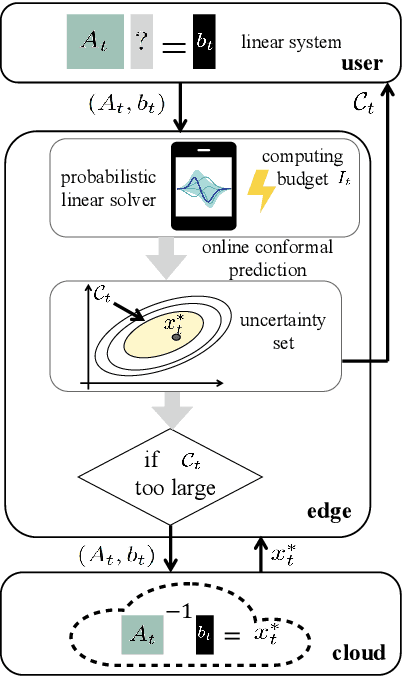
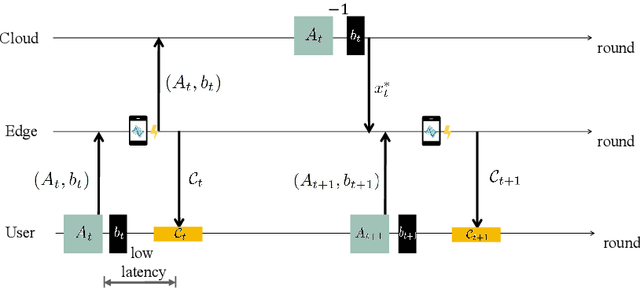


Abstract:Consider an edge computing setting in which a user submits queries for the solution of a linear system to an edge processor, which is subject to time-varying computing availability. The edge processor applies a probabilistic linear solver (PLS) so as to be able to respond to the user's query within the allotted time and computing budget. Feedback to the user is in the form of an uncertainty set. Due to model misspecification, the uncertainty set obtained via a direct application of PLS does not come with coverage guarantees with respect to the true solution of the linear system. This work introduces a new method to calibrate the uncertainty sets produced by PLS with the aim of guaranteeing long-term coverage requirements. The proposed method, referred to as online conformal prediction-PLS (OCP-PLS), assumes sporadic feedback from cloud to edge. This enables the online calibration of uncertainty thresholds via online conformal prediction (OCP), an online optimization method previously studied in the context of prediction models. The validity of OCP-PLS is verified via experiments that bring insights into trade-offs between coverage, prediction set size, and cloud usage.
Convergence Analysis of alpha-SVRG under Strong Convexity
Mar 16, 2025Abstract:Stochastic first-order methods for empirical risk minimization employ gradient approximations based on sampled data in lieu of exact gradients. Such constructions introduce noise into the learning dynamics, which can be corrected through variance-reduction techniques. There is increasing evidence in the literature that in many modern learning applications noise can have a beneficial effect on optimization and generalization. To this end, the recently proposed variance-reduction technique, alpha-SVRG [Yin et al., 2023] allows for fine-grained control of the level of residual noise in the learning dynamics, and has been reported to empirically outperform both SGD and SVRG in modern deep learning scenarios. By focusing on strongly convex environments, we first provide a unified convergence rate expression for alpha-SVRG under fixed learning rate, which reduces to that of either SGD or SVRG by setting alpha=0 or alpha=1, respectively. We show that alpha-SVRG has faster convergence rate compared to SGD and SVRG under suitable choice of alpha. Simulation results on linear regression validate our theory.
FedRand: Enhancing Privacy in Federated Learning with Randomized LoRA Subparameter Updates
Mar 11, 2025



Abstract:Federated Learning (FL) is a widely used framework for training models in a decentralized manner, ensuring that the central server does not have direct access to data from local clients. However, this approach may still fail to fully preserve data privacy, as models from local clients are exposed to the central server during the aggregation process. This issue becomes even more critical when training vision-language models (VLMs) with FL, as VLMs can easily memorize training data instances, making them vulnerable to membership inference attacks (MIAs). To address this challenge, we propose the FedRand framework, which avoids disclosing the full set of client parameters. In this framework, each client randomly selects subparameters of Low-Rank Adaptation (LoRA) from the server and keeps the remaining counterparts of the LoRA weights as private parameters. After training both parameters on the client's private dataset, only the non-private client parameters are sent back to the server for aggregation. This approach mitigates the risk of exposing client-side VLM parameters, thereby enhancing data privacy. We empirically validate that FedRand improves robustness against MIAs compared to relevant baselines while achieving accuracy comparable to methods that communicate full LoRA parameters across several benchmark datasets.
Calibrating Wireless AI via Meta-Learned Context-Dependent Conformal Prediction
Jan 24, 2025Abstract:Modern software-defined networks, such as Open Radio Access Network (O-RAN) systems, rely on artificial intelligence (AI)-powered applications running on controllers interfaced with the radio access network. To ensure that these AI applications operate reliably at runtime, they must be properly calibrated before deployment. A promising and theoretically grounded approach to calibration is conformal prediction (CP), which enhances any AI model by transforming it into a provably reliable set predictor that provides error bars for estimates and decisions. CP requires calibration data that matches the distribution of the environment encountered during runtime. However, in practical scenarios, network controllers often have access only to data collected under different contexts -- such as varying traffic patterns and network conditions -- leading to a mismatch between the calibration and runtime distributions. This paper introduces a novel methodology to address this calibration-test distribution shift. The approach leverages meta-learning to develop a zero-shot estimator of distribution shifts, relying solely on contextual information. The proposed method, called meta-learned context-dependent weighted conformal prediction (ML-WCP), enables effective calibration of AI applications without requiring data from the current context. Additionally, it can incorporate data from multiple contexts to further enhance calibration reliability.
Distilling Calibration via Conformalized Credal Inference
Jan 10, 2025
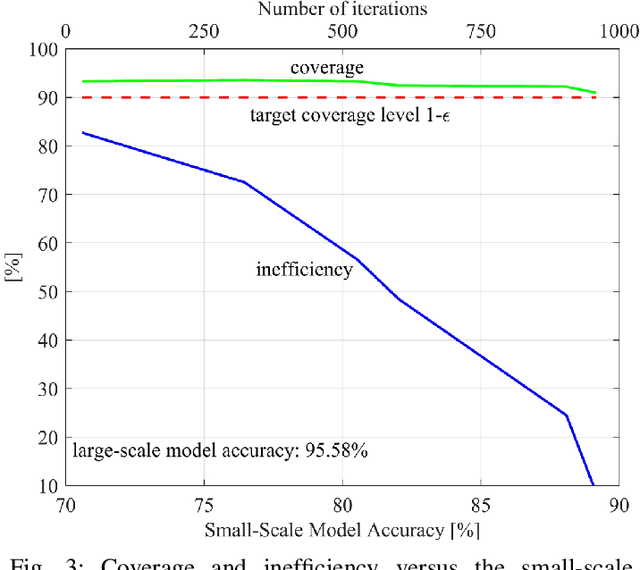
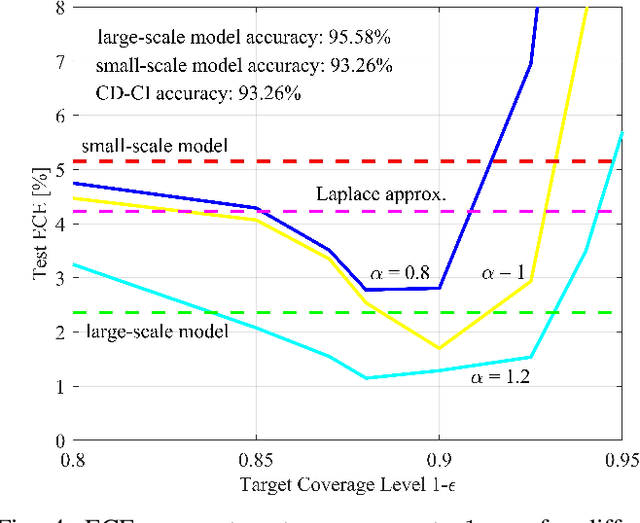
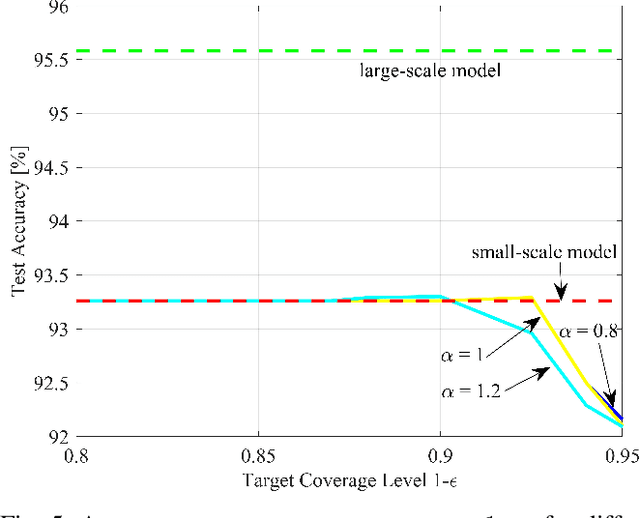
Abstract:Deploying artificial intelligence (AI) models on edge devices involves a delicate balance between meeting stringent complexity constraints, such as limited memory and energy resources, and ensuring reliable performance in sensitive decision-making tasks. One way to enhance reliability is through uncertainty quantification via Bayesian inference. This approach, however, typically necessitates maintaining and running multiple models in an ensemble, which may exceed the computational limits of edge devices. This paper introduces a low-complexity methodology to address this challenge by distilling calibration information from a more complex model. In an offline phase, predictive probabilities generated by a high-complexity cloud-based model are leveraged to determine a threshold based on the typical divergence between the cloud and edge models. At run time, this threshold is used to construct credal sets -- ranges of predictive probabilities that are guaranteed, with a user-selected confidence level, to include the predictions of the cloud model. The credal sets are obtained through thresholding of a divergence measure in the simplex of predictive probabilities. Experiments on visual and language tasks demonstrate that the proposed approach, termed Conformalized Distillation for Credal Inference (CD-CI), significantly improves calibration performance compared to low-complexity Bayesian methods, such as Laplace approximation, making it a practical and efficient solution for edge AI deployments.
 Add to Chrome
Add to Chrome Add to Firefox
Add to Firefox Add to Edge
Add to Edge